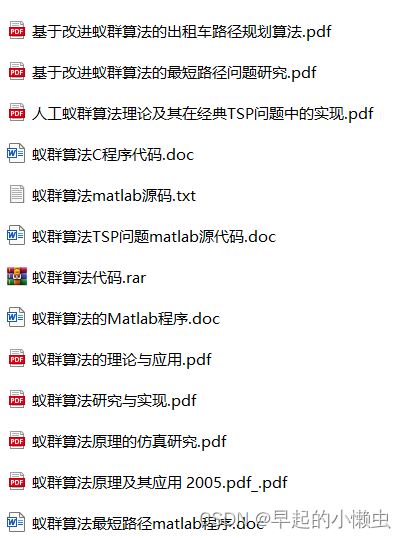数学建模算法模型--蚁群算法
有关蚁群算法学习资料分享:
链接:https://pan.baidu.com/s/10rY9OYN0ADfhKDXOK0R4fA?pwd=v09z
提取码:v09z
蚁群算法(Ant Colony Optimization,简称ACO)是一种基于模拟蚂蚁找食物路径行为的元启发式优化算法,常用于求解最优化问题。蚁群算法模拟了蚂蚁在寻找食物时留下信息素的过程,通过信息素的作用和蚂蚁的行为策略,找到全局最优解。
蚂蚁在寻找食物时,会在路径上释放一种化学物质——信息素,这种信息素可以吸引其它蚂蚁,从而形成路径上的信息素浓度。当其它蚂蚁在选择路径时,会倾向于选择信息素浓度较高的路径。这样,当蚂蚁数量增多时,信息素积累的效应会越来越强,最终会形成一个稳定的路径。
蚁群算法通过模拟蚂蚁寻找食物的过程,将问题转化为一个图论问题,其中每个节点表示问题的一个解,每个边表示两个解之间的转移概率。在搜索过程中,每只蚂蚁会根据当前的信息素浓度和启发式信息(例如距离、费用等)选择下一步要走的路径。当一只蚂蚁完成路径选择后,会更新路径上的信息素浓度。而全局最优解就是所有蚂蚁走过路径的最优解。
蚁群算法的优点在于可以处理多维度和复杂的优化问题,并且可以通过并行化来加快求解速度。不过,蚁群算法也存在一些缺点,如可能陷入局部最优解,对参数的选择敏感等。
常见的应用场景包括路径规划、最小生成树、聚类分析等。
蚁群算法应用案例和代码
以下是一个简单的 Python 蚁群算法实现,用于求解旅行商问题:
import numpy as np
import random
class AntColony:
def __init__(self, distances, n_ants=10, n_iterations=100, evaporation=0.5, alpha=1, beta=1):
self.distances = distances
self.n_ants = n_ants
self.n_iterations = n_iterations
self.evaporation = evaporation
self.alpha = alpha
self.beta = beta
self.pheromones = np.ones_like(distances) / len(distances)
def run(self):
best_path = None
best_distance = np.inf
for i in range(self.n_iterations):
paths = self._build_paths()
self._update_pheromones(paths)
distance = self._get_distance(paths[-1])
if distance < best_distance:
best_path = paths[-1]
best_distance = distance
print(f"Iteration {i + 1}: Distance = {distance}")
return best_path, best_distance
def _build_paths(self):
paths = []
for i in range(self.n_ants):
path = self._build_path(random.randint(0, len(self.distances) - 1))
paths.append(path)
return paths
def _build_path(self, start):
path = [start]
visited = set([start])
while len(path) < len(self.distances):
probs = self._get_probabilities(path[-1], visited)
next_city = self._select_next_city(probs)
path.append(next_city)
visited.add(next_city)
return path
def _get_probabilities(self, city, visited):
pheromones = self.pheromones[city]
distances = self.distances[city]
mask = np.ones_like(pheromones)
mask[list(visited)] = 0
pheromones *= mask
total = np.sum(np.power(pheromones, self.alpha) * np.power(1 / distances, self.beta))
return np.power(pheromones, self.alpha) * np.power(1 / distances, self.beta) / total
def _select_next_city(self, probs):
return np.random.choice(range(len(probs)), p=probs)
def _update_pheromones(self, paths):
pheromones = np.zeros_like(self.pheromones)
for path in paths:
distance = self._get_distance(path)
for i in range(len(path) - 1):
pheromones[path[i], path[i + 1]] += 1 / distance
self.pheromones = (1 - self.evaporation) * self.pheromones + self.evaporation * pheromones
def _get_distance(self, path):
distance = 0
for i in range(len(path) - 1):
distance += self.distances[path[i], path[i + 1]]
return distance
if __name__ == '__main__':
distances = np.array([[0, 1, 2, 3],
[1, 0, 4, 5],
[2, 4, 0, 6],
[3, 5, 6, 0]])
ant_colony = AntColony(distances)
best_path, best_distance = ant_colony.run()
print(f"Best path: {best_path}")
print(f"Best distance: {best_distance蚁群算法(Ant Colony Optimization,简称ACO)是一种基于自然界蚂蚁觅食行为的优化算法,属于群智能算法的一种。其基本思想是通过模拟蚂蚁在寻找食物时的行为,寻找问题的最优解。在蚂蚁寻找食物时,它们释放信息素,形成信息素路径,引导其他蚂蚁寻找食物。ACO算法基于这一思想,通过模拟信息素的作用,寻找最优解。
ACO算法适用于解决NP难问题,如TSP(旅行商问题)、图着色问题等。其具体步骤如下:
-
初始化:确定蚂蚁数量,信息素浓度、信息素挥发速度、启发函数等参数。然后在解空间中随机放置蚂蚁,每个蚂蚁随机选择一个起始点。
-
选择路径:蚂蚁根据信息素浓度和启发函数,以一定的概率选择下一个节点,直到找到一条完整路径。
-
更新信息素:每只蚂蚁在路径上留下信息素,信息素强度与路径的优良程度有关。信息素强度更新遵循信息素挥发速度和信息素增加速度的双重影响。
-
更新最优解:记录每一次迭代中找到的最优解,当连续若干次迭代中最优解未发生变化时,停止算法。
-
返回结果:算法结束后,返回记录的最优解。
ACO算法的优点在于可以找到局部最优解,并且容易实现和调整参数,但缺点是可能会陷入局部最优解。此外,ACO算法也具有一定的计算复杂度和运算时间。
以下是ACO算法的Python代码实现案例,以解决TSP问题为例:
import numpy as np
class AntColonyOptimizer:
def __init__(self, ant_count, generations, alpha, beta, rho, q, cities):
self.ant_count = ant_count
self.generations = generations
self.alpha = alpha
self.beta = beta
self.rho = rho
self.q = q
self.cities = cities
self.distance_matrix = self.calculate_distance_matrix()
self.pheromone_matrix = self.initialize_pheromone_matrix()
self.best_distance = np.inf
self.best_path = []
def calculate_distance_matrix(self):
city_count = len(self.cities)
distance_matrix = np.zeros((city_count, city_count))
for i in range(city_count):
for j in range(city_count):
if i != j:
distance_matrix[i][j] = np.linalg.norm(self.cities[i] - self.cities[j])
return distance_matrix
def initialize_pher
以下是蚁群算法的学习路线:
-
了解基本概念:学习蚁群算法的基本概念,包括蚂蚁、信息素、启发函数、局部搜索等。
-
学习算法原理:掌握蚁群算法的原理和基本流程,了解蚁群算法的优缺点和适用场景。
-
熟悉算法变体:了解蚁群算法的各种变体,如离散蚁群算法、连续蚁群算法、混合蚁群算法等。
-
学习应用案例:学习蚁群算法在各个领域的应用案例,如优化问题、路径规划、图像处理等。
-
编写代码实现:根据学习的蚁群算法原理和应用案例,使用编程语言实现蚁群算法,并对算法进行优化和改进。
-
调试和测试:测试实现的蚁群算法在各种情况下的性能和准确度,并进行调试和优化,以获得更好的结果。
-
应用到实际问题:将学习的蚁群算法应用到实际问题中,解决实际的优化、路径规划等问题。
-
深入研究和改进:在应用实践中不断深入研究和改进蚁群算法,使其更加适用于各种实际问题,并探索新的应用场景。
需要注意的是,蚁群算法作为一种智能优化算法,需要具备一定的数学基础,如优化理论、概率统计、线性代数等。同时,熟悉一门编程语言也是必要的,如Python、Java、C++等。
